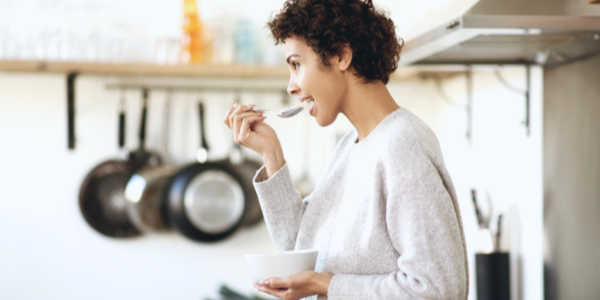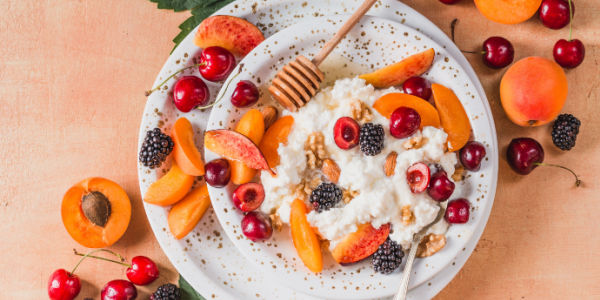
Nutrition affects nearly every aspect of one's life from disease prevention and management to work and exercise performance to, yes, even menstrual cycles and period cramps. Although periods are still somewhat of a taboo topic in mainstream culture, learning about and discussing them more can empower individuals to treat them more effectively.
Truly, there are foods that help with period cramps, so allow this article to illuminate the healthiest foods to eat on your period.
What to Eat on Your Period
While menstruation and its accompanying side effects are not always pleasant, it is an important female bodily function; sometimes considered a fifth or sixth vital sign of overall health. Luckily, there are many ways to remedy the major symptoms such as abdominal cramps, headaches, nausea, fatigue, bloating, mood swings, and diarrhea (that do not involve Midol)!
Consuming healthful foods and targeted nutrients is a potent way to decrease the dread of periods and manage them with ease. Without further ado, here is what to eat on your period:
Leafy Greens
These are potent powerhouses of nutrients any time of the month, but even more so during menstruation due to their high water content and magnesium and iron levels. Greens like kale, spinach, and arugula can reduce period-associated pain, fatigue, and headaches.
Fruits
Foods made mostly of water, like many fruits, help flush water and decrease bloating. They can also curb sugar cravings without a hefty punch of refined carbs that lead to blood sugar spikes and crashes.
Lean Proteins
Women lose more iron during their menstrual cycle, so it is imperative to replenish it with rich lean sources like chicken, fish, and turkey. High protein foods also help with satiation, and fish contains high amounts of omega-3 fatty acids, known to reduce depression and intensity of menstrual pain.
Turmeric
Thanks to the compound curcumin, an exemplary anti-inflammatory compound, turmeric can greatly reduce PMS and accompanying symptoms. This spice flavors Indian and Mediterranean dishes well and can also be drunk as a golden milk latte nowadays.
Dark Chocolate
Worry no more, dark chocolate is not a dire craving intent on sabotaging health. Rather, female bodies naturally crave more iron and magnesium during menses, as both reduce the severity of PMS symptoms. Chocolate bars that are 70 percent cocoa or above promise the best results.
Lentils and Beans
Foods in this category are wonderful sources of protein and iron for vegetarians and vegans who do not consume meat. While not absorbed as well as animal products, they still contribute to less painful period symptoms and improved energy levels.
Probiotic-Rich Foods
Yogurt, kombucha, sauerkraut, fermented soy, kefir, and other foods rich in probiotics can aid period problems. They do so by reducing bloating and other common gastrointestinal issues like diarrhea and constipation.
Whole Grains
As serotonin levels dip, the emotional roller coaster commences. This can lead to intense carb cravings.
Instead of reaching for refined versions like cookies or donuts, opt for wholesome options like whole-wheat toast or oats. These sources provide energizing and mood-lifting nutrients such as vitamin B6 and manganese.
Pumpkin and Chia Seeds
Both foods are especially high in tryptophan, an amino acid that is converted into the happy hormone, serotonin. Meaning, these are mood-lifting and sleep-regulating powerhouses. Pumpkin seeds are also chock-full of magnesium, known to improve positive mood, mitigate water retention, relax blood vessels, and ease headaches.
What to Drink
In addition to the above foods that help with period cramps and symptoms, the listed drinks below may also be helpful.
Water
The most vital nutrient of all, drinking more water during a menstrual cycle actually reduces water retention. It also rejuvenates cells, ensuring metabolism functions optimally.
Ginger Tea
Multiple studies show ginger helps with nixing nausea, calming period cramps, and even reducing heavy flows. An amount of 750 to 2,000 milligrams is an effective dose.
Chamomile Tea
Chamomile is frequently referred to as a calming agent because it increases urinary levels of glycine, which relieves muscle spasms and acts as a nerve relaxant. During menses, this means it eases cranky cramps and boosts positive moods.
Supplements/Natural Remedies to Try
While supplements and other natural remedies should not take the place of a balanced diet,
Saffron
Consuming this yellow-hued spice may significantly reduce depressive feelings by boosting serotonin.
Magnesium
Magnesium is a mighty mineral shown to ease period cramps, PMS, and menstrual migraines and certain forms also promote deeper sleep.
Chasteberry
A fruit found in central Asia and the Mediterranean, taking 40 milligrams (mg) per day during a menstrual cycle can effectively abate typical PMS symptoms and lesser-known ones like depression, anxiety, and breast pain.
Ginkgo Biloba
This old tree's leaves contain strong antioxidants and terpenoids that are known to reduce inflammation and anxiety and boost circulation. This trifecta of benefits naturally helps manage the shifting hormones responsible for PMS.
Foods to Avoid on Your Period
Of course, there are certain foods that exacerbate period symptoms like cramps and bloating. Although not the end all-be all, avoiding them one week of the month can provide additional relief, so why not try?
High Salt
The body begins to retain sodium and fluids during the days leading up to a menstrual cycle. Thus, eating extra salty foods like chips, canned foods, refined breads, pizza, cured meats, and take out can lead to more water retention, also known as bloating.
Refined Carbs/Sugar
As estrogen levels increase and progesterone levels decrease, the body retains water in preparation for a period. Carbs naturally lead to water retention, but this is exacerbated with refined and processed carbs like cookies, cakes, crackers, pastries, and most foods that come from a box or package.
Alcohol
Boozy drinks delay stomach emptying, which can consequently make one feel even more bloated. On top of that, alcohol naturally precipitates water retention and dehydration, exacerbating bloat and potentially leading to headaches, moodiness, and lethargy.
Dairy Products
Although calcium mitigates menses, it is best from other sources than dairy. This is because dairy contains arachidonic acids that stimulate prostaglandins (hormone derivative), which can intensify menstrual cramps.
Edamame, sardines, leafy greens, nuts, and chia seeds are alternative options of high calcium foods.
Red Meat
Yes, red meat is a great source of iron, but like dairy, it also consists of arachidonic acids. Instead, opt for iron-rich foods like leafy greens, chickpeas, chicken breast, and fish.
Other Remedies to Try
Even though nutrition is an excellent first line of defense and treatment, sometimes period symptoms still persist thanks to wonky hormone levels. If this happens, try one of the following fixes.
Applying Heat
Studies show that applying heat to the lower abdomen can reduce cramping. A heating mechanism, such as a heating pad, may even be as effective as Ibuprofen to weaken menstrual cramps.
Consider purchasing a heating pad, make your own, or use a bag of (heated) frozen peas.
Essential Oil Massage
Massaging the lower abdomen for up to 20 minutes and gently focusing on specific pressure points can also help relieve pain and cramps. Newer research suggests adding essential oils to the mix may enhance massage benefits.
Some of the most effective to try include lavender, clary sage, and marjoram.
Light Physical Activity
Lastly, light exercise such as walking or yoga can increase blood flow throughout the body, providing pain relief and boosting mood. It might be the least desirable activity when energy levels feel low during your period, but trust the professionals who boast it clearly works!
The Takeaway
Menstrual cycles can feel like a menacing burden when cared for improperly. However, nature has provided us with natural reprieve in the form of nourishing foods and various supplements.
Some of the most effective being fruits and vegetables, lean proteins, probiotics, pumpkin seeds, water, and chasteberry.
It is also smart to limit certain overly processed foods rich in salt and refined sugar, along with alcohol. These can exacerbate period symptoms, especially cramps and bloat.
Finally, when food is not fueling complete comfort try a gentle lower abdomen massage or yoga poses to further increase blood flow and calm that pesky but nonetheless vital uterus.
References:
Smith DL. 15 Best and Worst Foods for Your Period. Eat This Not That. Published October 22, 2020. https://www.eatthis.com/foods-for-period-symptoms/.
Sweet J. Buh-Bye Cramps, Bloating & Moodiness: 5 Supplements To Ease Period Symptoms. Mindbodygreen. Published June 13, 2020. https://www.mindbodygreen.com/articles/5-supplements-that-can-help-with-period-symptoms.
Whelan C. 16 Foods to Eat (and Some to Avoid) During Your Period. Healthline. Published October 29, 2019. https://www.healthline.com/health/womens-health/what-to-eat-during-period.
Wilson DR. Menstrual Cramp Home Remedies for Natural Relief. Healthline. Published May 5, 2020. https://www.healthline.com/health/womens-health/menstrual-cramp-remedies.







